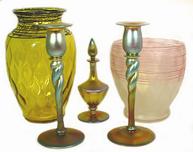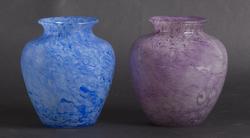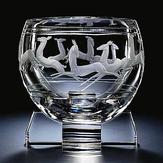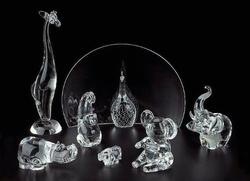National Depression Glass Association
Preserving America's Glass Manufacturing Heritage
Steuben Glass
Courtesy of Collectors Weekly
(Click on any of the images to see a larger version)
When collectors think of Steuben glass, two distinct styles come to mind. The first was pioneered by Steuben co-founder Frederick Carder in 1903. As Steuben's chief
 designer, Carder created a new form of iridescent glass called Aurene. Unlike Tiffany's dense and dark Favrile line of iridescent glass, which was introduced in 1894, Carder's Aurene pieces were luminous and lustrous, seeming to radiate more light than they absorbed.
designer, Carder created a new form of iridescent glass called Aurene. Unlike Tiffany's dense and dark Favrile line of iridescent glass, which was introduced in 1894, Carder's Aurene pieces were luminous and lustrous, seeming to radiate more light than they absorbed.
So distinctive was Aurene from Favrile that Steuben was granted a patent on the technique in 1904, the year after the company's founding. That did not stop Tiffany from filing a lawsuit against Steuben, although the case was tabled when Carder pointed out that the Bohemians had been using iridescent techniques since the middle of the 19th century.
It's likely Tiffany would not have prevailed anyway: Not only were Carder's Aurene surfaces different from Tiffany's, the shapes of his objects were unlike Tiffany's, too. Favrile forms and surface decorations tended to the organic and naturalistic--they were pure Art Nouveau. Steuben's Aurene vases, bowls, and candlesticks flirted with Art Nouveau, but Carder never strayed far from classical forms and used decoration sparingly.
So successful was Carder's Aurene that Steuben's earliest years were largely devoted to its production. Gold was a favorite color, sometimes paired with white or shades of green or red. Blue Aurene was a Steuben glass mainstay--some blue Aurene Steuben vases had concave bodies and ruffled rims; others were squat and almost utilitarian looking.
 By the 1910s, Egyptian shapes (tall vases with collared necks and high shoulders) were added to the company's repertoire.
By the 1910s, Egyptian shapes (tall vases with collared necks and high shoulders) were added to the company's repertoire.
 In 1918, with World War I still raging, lead, an important component of crystal, was rationed for the war effort. Steuben quickly needed a partner to weather the resulting economic downturn, so it sold to nearby Corning Glassworks, which made it a division of the larger company.
In 1918, with World War I still raging, lead, an important component of crystal, was rationed for the war effort. Steuben quickly needed a partner to weather the resulting economic downturn, so it sold to nearby Corning Glassworks, which made it a division of the larger company.
Carder remained in charge of Steuben during the 1920s, and though his style evolved, he did not shake his classical predispositions. Many Steuben vases from this period were acid etched and suggested the influence of Art Deco. One alabaster, urn-like vase featured an acid-etched scene of leaping deer in a stylized hunting landscape on a red background. Other pieces resembled ginger jars from Asia, with green-on-green patterns of curly-cues and cartoon dragons. Even Steuben's Cluthra vases (below, left), with their distinctive air bubbles trapped just below the surface, were acid-etched with decorative, floral designs.
It was beautiful stuff, but the public mostly yawned, which is why in 1933, three decades after he had helped found Steuben, Carder was replaced by sculptor Sidney Waugh.
 During his time as Steuben's chief designer, Carder had been extraordinarily prolific, producing more than 5,000 shapes and some 60 unique colors and designs. As a result, a lot of glass had piled up in the Steuben warehouse. As if to dramatize the changing of the guard, great volumes of Steuben glass from the Carder years were sold as factory leftovers, after which most of the rest was destroyed in what Corning locals called "The Smashing." It was literally out with the old and in with the new.
During his time as Steuben's chief designer, Carder had been extraordinarily prolific, producing more than 5,000 shapes and some 60 unique colors and designs. As a result, a lot of glass had piled up in the Steuben warehouse. As if to dramatize the changing of the guard, great volumes of Steuben glass from the Carder years were sold as factory leftovers, after which most of the rest was destroyed in what Corning locals called "The Smashing." It was literally out with the old and in with the new.
Waugh would help give Steuben its second great look--clear crystal. The change was partly due to Waugh's different aesthetic sensibility from Carder's, but a major factor in the shift at Steuben was a technological breakthrough on the part of Corning Glass chemists. Known as 10M, this new glass recipe permitted the full spectrum of light to pass through it, including ultra-violet waves, creating unprecedentedly clear crystal. Almost all Steuben crystal products produced in the years following this innovation were made out of 10M--from stemware to bowls to drinking glasses to urns.

The designs that came to mark this era of transition were heavily influenced by Art Deco. Large cut or blown bowls and vases were routinely engraved using copper-wheel techniques. Right away, Waugh made his mark, just as Carder had done years before. His watershed was a 1935 piece called the Gazelle Bowl (shown at right). It featured a large circular crystal bowl set in four rectangular bottom pieces, with engravings of twelve gazelles prancing around the bowl's circumference. That year, Waugh's Gazelle Bowl, Zodiac Bowl, and a vase called Agnus Dei were added to the collection of the Metropolitan Museum in New York.
Until this point, Steuben had been a fairly insular world, but in 1940 the company collaborated with 27 internationally renowned artists, including Georgia O'Keefe, Henri Matisse, Isamu Noguchi, Salvador Dali, Paul Manship, and Thomas Hart Benton. The two-month exhibition of engraved glass objects created by these artists was so popular that Steuben had to lock the doors of its Fifth Avenue store several times a day to control the crowds.
Sales sank during World War II, but Steuben participated in the post-war expansion that followed. Steuben designer Walter Teague turned to the drawings of John J. Audubon to create a series of 10-inch plates, each of which featured an engraving of a different bird on its base. In 1947, the U.S. Ambassador to the United Kingdom, Lewis William Douglas, and his wife, Peggy, presented a set of the Steuben Audubon plates to Princess Elizabeth as a wedding present.
 Tasteful design, even tasteful packaging, became a hallmark during the 1950s, and crystal hand coolers in the rounded shapes of animals became a Steuben trademark. Also during the 1950s, Steuben designers began to individualize their art glass pieces, playing with shape, proportion, and even asymmetry. This experimental aesthetic continued into the 1960s, reflecting the abstract geometrical trend that was popular at the time. Steuben even produced a series of pieces inspired by such poets as W.H. Auden, Marianne Moore, and William Carlos Williams.
Tasteful design, even tasteful packaging, became a hallmark during the 1950s, and crystal hand coolers in the rounded shapes of animals became a Steuben trademark. Also during the 1950s, Steuben designers began to individualize their art glass pieces, playing with shape, proportion, and even asymmetry. This experimental aesthetic continued into the 1960s, reflecting the abstract geometrical trend that was popular at the time. Steuben even produced a series of pieces inspired by such poets as W.H. Auden, Marianne Moore, and William Carlos Williams.
In November of 2011, the Steuben Glass factory in Corning, New York, which had been operated by Schottenstein Corporations of Ohio since 2008, closed its doors. The rights to the Steuben name were sold back to Corning Incorporated, but it's unclear if signature pieces such as the Gazelle Bowl will ever be produced again.
Webmaster's note: The text of this article was first published on the Collectors Weekly web site and is used by permission of Collectors Weekly.